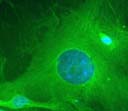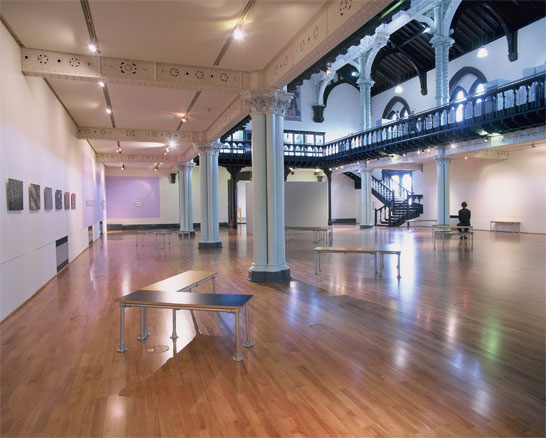Meet the scientists
18-August-2010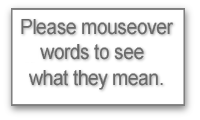
Meet the scientists
Lung cancer
Being a vet might seem an ideal job for a young man with an interest in disease. But it failed to satisfy Claudio Murgia's scientific curiosity, he says. "You see a disease and you ask what is the mechanism? But as a vet you can't answer that question. You just go 'That is the symptom, now here is the cure.'
 "But for me it was always 'That is the symptom, now what is the cause?' So I was reading books and finding out many interesting things. Eventually I decided to see if I could do science, and I went from my home in Italy to California to do a PhD."
"But for me it was always 'That is the symptom, now what is the cause?' So I was reading books and finding out many interesting things. Eventually I decided to see if I could do science, and I went from my home in Italy to California to do a PhD."
It was an unusual route into science research as a career and now, ten years later, Dr Murgia is still on the road less travelled, as he investigates the origins of human lung cancer using sheep rather than mice as a laboratory model. This is more difficult, but the potential is greater, he firmly believes.
"Lung cancer in sheep and humans is very similar. So natural lung cancer in sheep is a very good model for the disease in humans. We know that in sheep it is caused by a retrovirus. There are two main questions: How does the virus cause cancer and what kind of cells does it infect. So we are doing experiments to answer those questions."
There has been progress but there are no easy answers with this disease, he says. "Cancer is very complex and you can't really study it in a petri dish. You need the in vivo where there are lots of other cells, such as immune cells that are attacking the tumour, to test hypotheses.
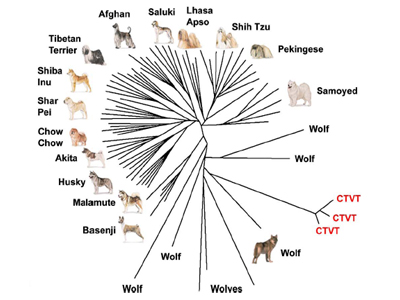
"This is a disease of adult sheep. But scientists trying to produce it experimentally could only do so in lambs. That was strange. So what was the difference? The answer is stem cells, which repair tissue. The lamb has many of these because it is developing, the adult very few. So to enable the virus to infect we devised a technique that destroyed normal cells, so the stem cells would start dividing. The virus infects cells that are in division, so after ten days the tumour forms."
While the sheep model is technically excellent, says Dr Murgia, it is professionally challenging. "You invest a lot of time without publishing, because you have to set up the system and develop the tools. In mice all these are already available. The most important part is belief in what you are doing. You have to be strong.
"But I am studying cancer mostly because I want to help humans. So if I believe the sheep model is closer to the human that is what I must invest my time in. I believe in the concept of one medicine.
"Every day you learn something new, you have new challenges, you read something interesting. If you want to solve a big problem it takes many years. You never stop thinking, even when you go to bed at night. I will be working on this for the rest of my life."
More help with words
| bacteria | cell | complex | conception | DNA | experiment |
| gene | inherit | journal | laboratory | membrane | micro-organisms |
| molecules | paper | predictions | protein | protoplasm | |
| research | RNA | tentative | tissue | virus |
Inherited disease
Science and art can seem like complete opposites, the one fixed firmly in reality, the other bounded only by the imagination. But artists and scientists can work very well together, says Darren Monckton.
"I've collaborated on several projects with artist Jacqueline Donachie, whose family has an inherited disease called myotonic dystrophy – which is my area of research. We produced a book and then put on an exhibition at the Hunterian Art Gallery."
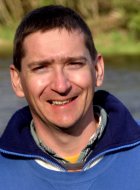
Myotonic dystrophy is a muscle disorder that grows progressively more severe with age, explains Professor Monckton. "But it also does something strange – the severity of the disease gets worse from one generation to the next."
For a long time this couldn't be explained by genetics, so researchers didn't believe it, he says. "But we now know the molecular explanation. It's to do with repeated DNA sequences. The more copies of these repeats you have, the worse the symptoms. And the number of repeats increases from one generation to the next.
"The simple explanation is that when you have these repeats the DNA no longer adopts the classic double helix, but forms a new shape which the cell recognises and tries to repair. But instead it makes it worse, and it goes round and round, getting worse each time."
A similar effect seems to cause the progression of the disease within one individual, he says. "Everyone assumed it was a failure to repair the DNA. We now know the repair machinery needs to be there and working. But there is still a lot we don't know.
For Professor Monckton this is the appeal of science – it's like a huge jigsaw puzzle, he says, but more exciting. "You don't know what the picture is and you've only got half the pieces. You try to fit those you have together, guess the picture, then look for the missing pieces."
Progress is usually through fitting small new pieces to the puzzle, he says. Occasionally pieces have to be pulled apart because 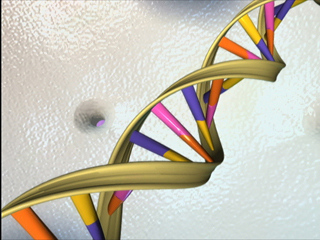 they're in the wrong place. But every now and then a big new piece of the puzzle is fitted into place.It's those moments a scientist lives for, he says.
they're in the wrong place. But every now and then a big new piece of the puzzle is fitted into place.It's those moments a scientist lives for, he says.
"You want an example? Well early in my career I was working in the lab that developed DNA fingerprinting at Leicester with Alex Jeffreys. One night when I was going to the theatre I suddenly had an insight and could hardly stay in my seat I was so desperate to get back to the lab to check that it was right.
"I've had two other real Eureka moments in my work." he smiles. "So far."
The appeal of working on a disease like myotonic dystrophy – rather than much more common diseases – is that the researchers are making considerable progress, he says. "It is a relatively simple genetic disease and it's tractable. There will still be people getting cancer in 30 years' time. But I firmly believe we will have a cure for this disease in my lifetime."
More help with words
| average | conception | fertilisation | DNA | experiment | gene |
| helix | inherit | molecule | sample | tissue |
Rehabilitation engineering

People get the wrong idea about engineering because there aren't enough words for it in the English language, says Aleksandra Vuckovic. "In this country if you talk about engineering, people think about something you do with dirty hands, or that you can fix their TVs or washing machines.
"In Serbia it is a much more highly respected profession. The best students go into engineering or medicine. I think it has something to do with language. We have loads of different words for engineer, and you can tell a person's qualifications right away when you hear the word that applies to them."
The confusion in this country means engineering departments have their work cut out to help schools understand what engineers are and what they do, says Dr Vuckovic. "That's part of my job. University lecturers have a mix of teaching and research duties, as well as administration. So I am publicity officer for schoolchildren who might want to study mechanical engineering at Glasgow University."
The research part of the job is a little more complicated, she says. "We are developing devices and techniques to help people who have problems to move or feel their bodies. We work closely with the spinal injury unit at the Southern General.
"What we do is study tiny signals from people's brains and try to work out what they are thinking. If we can do that we can then use those signals as commands for a computer."
The next step can be sending an electrical signal to a specific muscle in a person's body to make it contract, or to a mechanical device such as an artificial hand or a wheelchair. The difficult part is matching the signal to the correct action, because Dr Vuckovic and her team are detecting brain waves by attaching electrodes to the outside of the skull, without penetrating it. This means the signals are faint and often confused by other electrical noise.
Electrodes that can be implanted in the brain and left there for a long time will open up wonderful possibilities, says Dr Vuckovic – such as direct brain control of prosthetics or even parts of the body whose connections to the brain have been lost or damaged. "But nobody knows yet how to create biocompatible materials. So we work with therapist's electrodes. 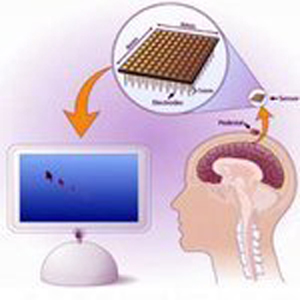 Our focus is rehabilitation."
Our focus is rehabilitation."
People who lose the ability to move their hands through spinal injury need to work hard in the first few months to recover it. If they leave it longer than that the parts of the brain that control the unused muscles will start doing other jobs. "It's called brain plasticity and it's very useful when you're learning a new skill, such as playing the piano," she says. "But we're dealing with disuse plasticity, which is a problem."
The setup she and her team are testing has a patient fitted with an EEG cap of electrodes, who then tries to imagine opening the hand. The computer recognises the pattern of brain waves and sends a signal to electrodes attached to the wrist that stimulate the right muscles to do so. "We have tested this system with healthy people and it works well," says Dr Vuckovic. "They learn very quickly how they have to think to make it happen.
"We now need to find out if it will work with people who have real injuries. That is what we are beginning to test now. I think that it will work but I expect it will take them longer to learn. How long? That is what we will soon find out."
In September 2010 the course for the first biomedical engineering degree (undergraduate) to be offered by a Scottish university begins at Glasgow.
More help with words
| artificial | conductor | instrument | observe |
| random | regular | structure |

